影响腐蚀的结构因素
- 格式:ppt
- 大小:225.00 KB
- 文档页数:14
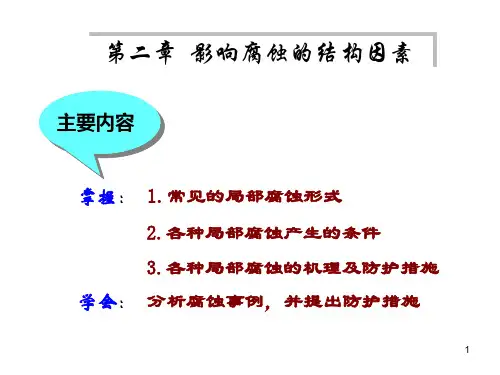
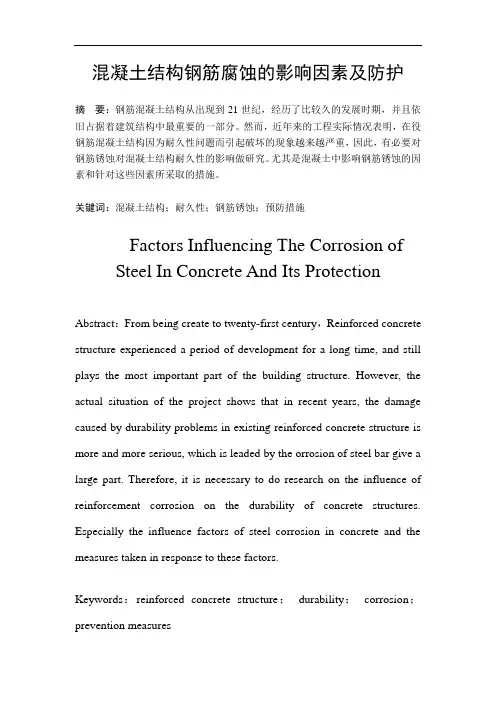
混凝土结构钢筋腐蚀的影响因素及防护摘要:钢筋混凝土结构从出现到21世纪,经历了比较久的发展时期,并且依旧占据着建筑结构中最重要的一部分。
然而,近年来的工程实际情况表明,在役钢筋混凝土结构因为耐久性问题而引起破坏的现象越来越严重,因此,有必要对钢筋锈蚀对混凝土结构耐久性的影响做研究。
尤其是混凝土中影响钢筋锈蚀的因素和针对这些因素所采取的措施。
关键词:混凝土结构;耐久性;钢筋锈蚀;预防措施Factors Influencing The Corrosion ofSteel In Concrete And Its ProtectionAbstract:From being create to twenty-first century,Reinforced concrete structure experienced a period of development for a long time, and still plays the most important part of the building structure. However, the actual situation of the project shows that in recent years, the damage caused by durability problems in existing reinforced concrete structure is more and more serious, which is leaded by the orrosion of steel bar give a large part. Therefore, it is necessary to do research on the influence of reinforcement corrosion on the durability of concrete structures. Especially the influence factors of steel corrosion in concrete and the measures taken in response to these factors.Keywords:reinforced concrete structure;durability;corrosion;prevention measures0 引言最开始人们认为,钢筋混凝土结构很好地结合了钢筋与混凝土材料的优点,可模性好、可塑性强、整体性好、耐久性好、后期维护费用较低以及易于就地取材等诸多优点使得当今世界上的建筑大多选择采用钢筋混凝土结构。
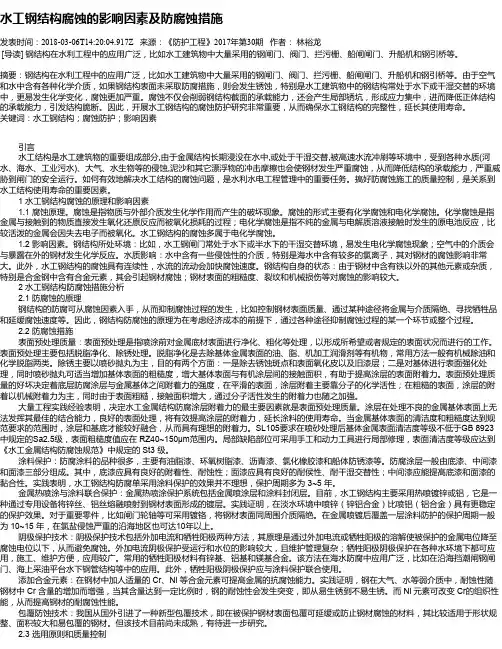
水工钢结构腐蚀的影响因素及防腐蚀措施发表时间:2018-03-06T14:20:04.917Z 来源:《防护工程》2017年第30期作者:林裕龙[导读] 钢结构在水利工程中的应用广泛,比如水工建筑物中大量采用的钢闸门、阀门、拦污栅、船闸闸门、升船机和钢引桥等。
摘要:钢结构在水利工程中的应用广泛,比如水工建筑物中大量采用的钢闸门、阀门、拦污栅、船闸闸门、升船机和钢引桥等。
由于空气和水中含有各种化学介质,如果钢结构表面未采取防腐措施,则会发生锈蚀,特别是水工建筑物中的钢结构常处于水下或干湿交替的环境中,更易发生化学变化,腐蚀更加严重。
腐蚀不仅会削弱钢结构截面的承载能力,还会产生局部锈坑,形成应力集中,进而降低正体结构的承载能力,引发结构脆断。
因此,开展水工钢结构的腐蚀防护研究非常重要,从而确保水工钢结构的完整性,延长其使用寿命。
关键词:水工钢结构;腐蚀防护;影响因素引言水工结构是水工建筑物的重要组成部分,由于金属结构长期浸没在水中,或处于干湿交替,被高速水流冲刷等环境中,受到各种水质(河水、海水、工业污水)、大气、水生物等的侵蚀,泥沙和其它漂浮物的冲击摩擦也会使钢材发生严重腐蚀,从而降低结构的承载能力,严重威胁到闸门的安全运行。
如何有效地解决水工结构的腐蚀问题,是水利水电工程管理中的重要任务。
搞好防腐蚀施工的质量控制,是关系到水工结构使用寿命的重要因素。
1 水工钢结构腐蚀的原理和影响因素 1.1 腐蚀原理。
腐蚀是指物质与外部介质发生化学作用而产生的破坏现象。
腐蚀的形式主要有化学腐蚀和电化学腐蚀。
化学腐蚀是指金属与接触到的物质直接发生氧化还原反应而被氧化损耗的过程;电化学腐蚀是指不纯的金属与电解质溶液接触时发生的原电池反应,比较活泼的金属会因失去电子而被氧化。
水工钢结构的腐蚀多属于电化学腐蚀。
1.2 影响因素。
钢结构所处环境:比如,水工钢闸门常处于水下或半水下的干湿交替环境,易发生电化学腐蚀现象;空气中的介质会与暴露在外的钢材发生化学反应。
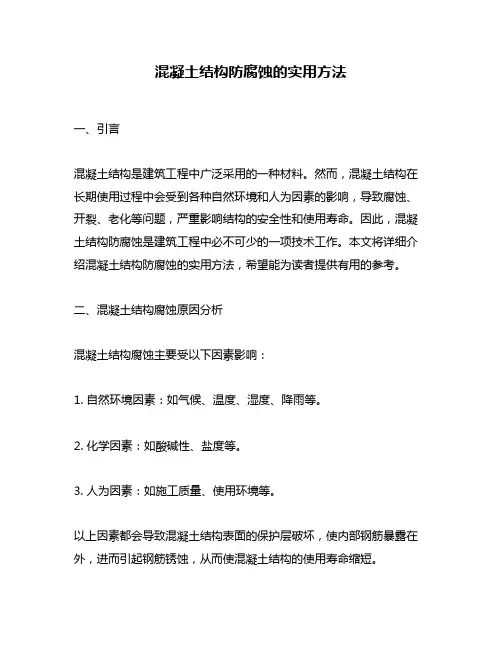
混凝土结构防腐蚀的实用方法一、引言混凝土结构是建筑工程中广泛采用的一种材料。
然而,混凝土结构在长期使用过程中会受到各种自然环境和人为因素的影响,导致腐蚀、开裂、老化等问题,严重影响结构的安全性和使用寿命。
因此,混凝土结构防腐蚀是建筑工程中必不可少的一项技术工作。
本文将详细介绍混凝土结构防腐蚀的实用方法,希望能为读者提供有用的参考。
二、混凝土结构腐蚀原因分析混凝土结构腐蚀主要受以下因素影响:1. 自然环境因素:如气候、温度、湿度、降雨等。
2. 化学因素:如酸碱性、盐度等。
3. 人为因素:如施工质量、使用环境等。
以上因素都会导致混凝土结构表面的保护层破坏,使内部钢筋暴露在外,进而引起钢筋锈蚀,从而使混凝土结构的使用寿命缩短。
三、混凝土结构防腐蚀的实用方法1. 表面防护混凝土结构的表面防护是防止混凝土结构表面保护层受到破坏,进而保护结构内部钢筋不受腐蚀的重要手段。
表面防护的方法包括:(1)涂层防护:涂层防护是目前最常用的混凝土表面防护方法。
涂层可以涂刷在混凝土表面,形成一层保护膜,防止外界环境对混凝土结构的侵蚀。
常用的涂层材料有聚氨酯、环氧树脂、有机硅等。
(2)砖瓦、石材等外覆层:这种方法适用于一些特殊的建筑结构,如立面墙等。
外覆层可以形成一个保护膜,防止混凝土结构受到侵蚀。
(3)喷涂混凝土:喷涂混凝土也是一种表面防护方法,它可以在混凝土表面形成一个厚实的保护层,保护混凝土结构的表面不受侵蚀。
2. 钢筋防护钢筋防护是防止钢筋锈蚀的重要手段。
钢筋防护的方法包括:(1)阴极保护:阴极保护是一种电化学方法,它可以通过施加电流的方式将钢筋表面变成阴极,从而防止钢筋发生氧化反应。
阴极保护广泛应用于桥梁、隧道、码头等混凝土结构中。
(2)涂层防护:涂层防护也可以应用于钢筋防护。
涂层可以在钢筋表面形成一层保护膜,防止外界的氧化物对钢筋的侵蚀。
常用的涂层材料有环氧树脂、有机硅等。
(3)缩小混凝土裂缝:当混凝土结构发生裂缝时,裂缝会使钢筋暴露在外,容易受到氧化物的侵蚀。
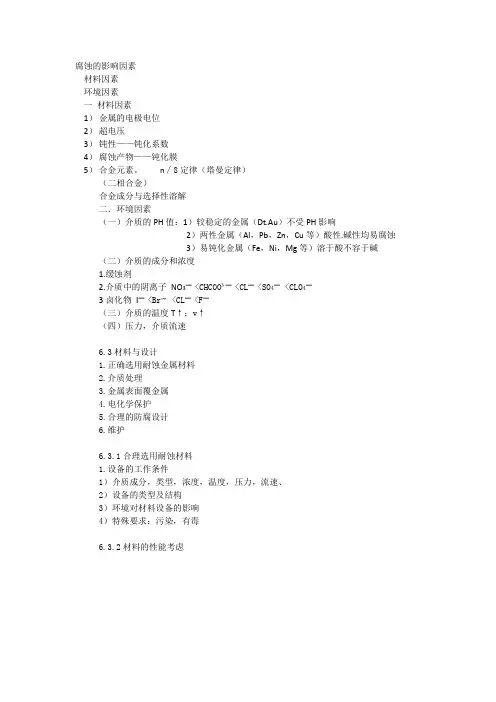
腐蚀的影响因素
材料因素
环境因素
一材料因素
1)金属的电极电位
2)超电压
3)钝性——钝化系数
4)腐蚀产物——钝化膜
5)合金元素。
n∕8定律(塔曼定律)
(二相合金)
合金成分与选择性溶解
二.环境因素
(一)介质的PH值:1)较稳定的金属(Dt.Au)不受PH影响
2)两性金属(Al,Pb,Zn,Cu等)酸性.碱性均易腐蚀
3)易钝化金属(Fe,Ni,Mg等)溶于酸不容于碱(二)介质的成分和浓度
1.缓蚀剂
2.介质中的阴离子NO3▔<CHCOO³▔<CL▔<SO4▔ <CLO4▔
3卤化物I▔<Br▔<CL▔<F▔
(三)介质的温度T↑;v↑
(四)压力,介质流速
6.3材料与设计
1.正确选用耐蚀金属材料
2.介质处理
3.金属表面覆金属
4.电化学保护
5.合理的防腐设计
6.维护
6.3.1合理选用耐蚀材料
1.设备的工作条件
1)介质成分,类型,浓度,温度,压力,流速、
2)设备的类型及结构
3)环境对材料设备的影响
4)特殊要求:污染,有毒
6.3.2材料的性能考虑。

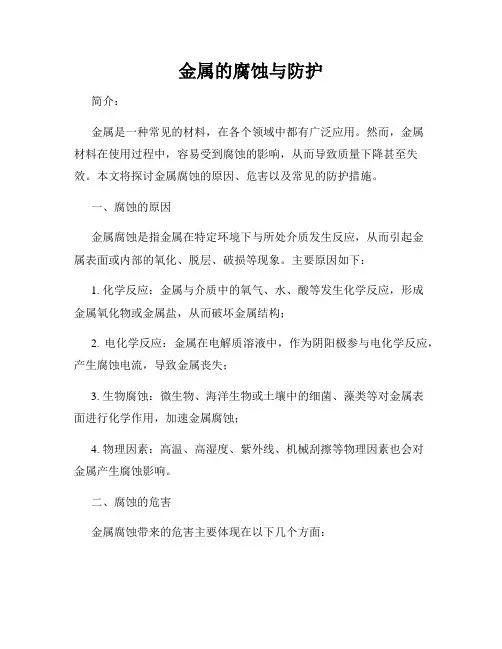
金属的腐蚀与防护简介:金属是一种常见的材料,在各个领域中都有广泛应用。
然而,金属材料在使用过程中,容易受到腐蚀的影响,从而导致质量下降甚至失效。
本文将探讨金属腐蚀的原因、危害以及常见的防护措施。
一、腐蚀的原因金属腐蚀是指金属在特定环境下与所处介质发生反应,从而引起金属表面或内部的氧化、脱层、破损等现象。
主要原因如下:1. 化学反应:金属与介质中的氧气、水、酸等发生化学反应,形成金属氧化物或金属盐,从而破坏金属结构;2. 电化学反应:金属在电解质溶液中,作为阴阳极参与电化学反应,产生腐蚀电流,导致金属丧失;3. 生物腐蚀:微生物、海洋生物或土壤中的细菌、藻类等对金属表面进行化学作用,加速金属腐蚀;4. 物理因素:高温、高湿度、紫外线、机械刮擦等物理因素也会对金属产生腐蚀影响。
二、腐蚀的危害金属腐蚀带来的危害主要体现在以下几个方面:1. 结构破损:金属腐蚀导致金属结构受损,影响其使用寿命,甚至引发安全事故;2. 功能下降:腐蚀使金属表面变得不平整、粗糙,降低了其原有的功能,如电导性、导热性等;3. 资源浪费:腐蚀使金属材料减少,需要更多的资源进行修复和替换,增加了成本和能源消耗;4. 环境污染:金属腐蚀产生的废物、气体和废水会对环境造成污染,对植物和动物产生不良影响。
三、金属腐蚀的防护措施为了减少金属腐蚀的发生,需要采取一系列的防护措施。
以下是常见的几种防护方法:1. 表面涂层:通过涂覆金属表面的保护膜,阻隔介质对金属的侵蚀。
常见的涂层包括漆膜、涂层、电镀层等;2. 阳极保护:在金属表面附近放置一个具有更高活性的金属,作为阳极进行保护,使其更容易受到腐蚀。
常见的阳极保护材料包括锌合金、铝合金等;3. 防蚀合金:将金属与其他元素进行合金化处理,提高其抗腐蚀性能。
如不锈钢中的铬能形成致密的氧化膜,阻隔外界介质;4. 缓蚀剂:添加适量的缓蚀剂到金属表面,形成保护膜,减缓腐蚀速度。
常见的缓蚀剂有无机盐、有机酸等;5. 电化学防蚀:利用电化学原理,通过施加外电场或电流,实现金属防蚀。
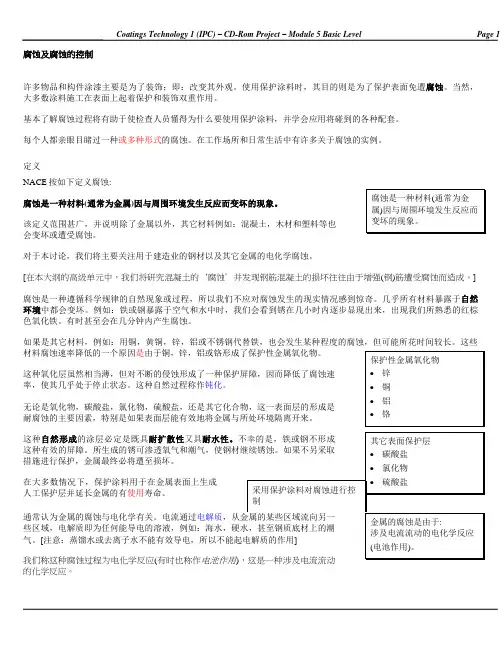
腐蚀及腐蚀的控制许多物品和构件涂漆主要是为了装饰;即:改变其外观。
使用保护涂料时,其目的则是为了保护表面免遭腐蚀。
当然,大多数涂料施工在表面上起着保护和装饰双重作用。
基本了解腐蚀过程将有助于使检查人员懂得为什么要使用保护涂料,并学会应用将碰到的各种配套。
每个人都亲眼目睹过一种或多种形式的腐蚀。
在工作场所和日常生活中有许多关于腐蚀的实例。
定义NACE 按如下定义腐蚀:腐蚀是一种材料(通常为金属)因与周围环境发生反应而变坏的现象。
该定义范围甚广,并说明除了金属以外,其它材料例如:混凝土,木材和塑料等也会变坏或遭受腐蚀。
对于本讨论,我们将主要关注用于建造业的钢材以及其它金属的电化学腐蚀。
[在本大纲的高级单元中,我们将研究混凝土的‘腐蚀’并发现钢筋混凝土的损坏往往由于增强(钢)筋遭受腐蚀而造成。
] 腐蚀是一种遵循科学规律的自然现象或过程,所以我们不应对腐蚀发生的现实情况感到惊奇。
几乎所有材料暴露于自然环境中都会变坏。
例如:铁或钢暴露于空气和水中时,我们会看到锈在几小时内逐步显现出来,出现我们所熟悉的红棕色氧化铁。
有时甚至会在几分钟内产生腐蚀。
如果是其它材料,例如:用铜,黄铜,锌,铝或不锈钢代替铁,也会发生某种程度的腐蚀,但可能所花时间较长。
这些材料腐蚀速率降低的一个原因是由于铜,锌,铝或铬形成了保护性金属氧化物。
这种氧化层虽然相当薄,但对不断的侵蚀形成了一种保护屏障,因而降低了腐蚀速率,使其几乎处于停止状态。
这种自然过程称作钝化。
无论是氧化物,碳酸盐,氯化物,硫酸盐,还是其它化合物,这一表面层的形成是耐腐蚀的主要因素,特别是如果表面层能有效地将金属与所处环境隔离开来。
这种自然形成的涂层必定是既具耐扩散性又具耐水性。
措施进行保护,金属最终必将遭至损坏。
在大多数情况下,保护涂料用于在金属表面上生成人工保护层并延长金属的有使用寿命。
通常认为金属的腐蚀与电化学有关。
电流通过电解质气。
[我们称这种腐蚀过程为电化学反应(有时也称作电池作用)的化学反应。
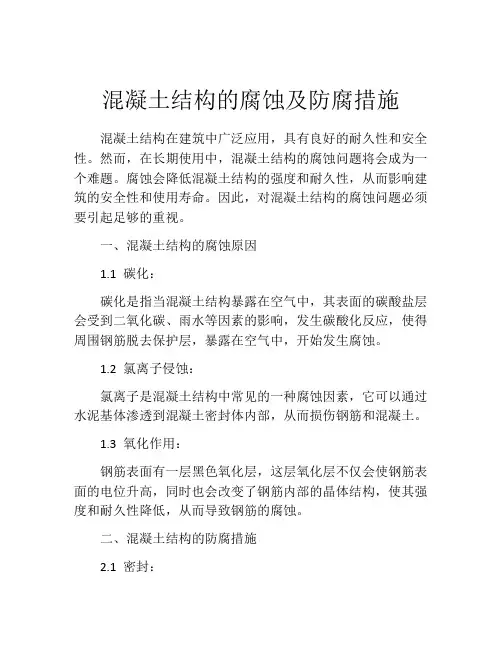
混凝土结构的腐蚀及防腐措施混凝土结构在建筑中广泛应用,具有良好的耐久性和安全性。
然而,在长期使用中,混凝土结构的腐蚀问题将会成为一个难题。
腐蚀会降低混凝土结构的强度和耐久性,从而影响建筑的安全性和使用寿命。
因此,对混凝土结构的腐蚀问题必须要引起足够的重视。
一、混凝土结构的腐蚀原因1.1 碳化:碳化是指当混凝土结构暴露在空气中,其表面的碳酸盐层会受到二氧化碳、雨水等因素的影响,发生碳酸化反应,使得周围钢筋脱去保护层,暴露在空气中,开始发生腐蚀。
1.2 氯离子侵蚀:氯离子是混凝土结构中常见的一种腐蚀因素,它可以通过水泥基体渗透到混凝土密封体内部,从而损伤钢筋和混凝土。
1.3 氧化作用:钢筋表面有一层黑色氧化层,这层氧化层不仅会使钢筋表面的电位升高,同时也会改变了钢筋内部的晶体结构,使其强度和耐久性降低,从而导致钢筋的腐蚀。
二、混凝土结构的防腐措施2.1 密封:对于混凝土结构的密封方法可以分为表面密封和浸泡密封。
表面密封是通过喷涂或刷涂防水材料,来形成一个密封层;浸泡密封则是将混凝土结构浸泡在防水材料中,使其完全被防水材料包裹。
密封可以减少外部因素的侵蚀,延长混凝土结构的使用寿命。
2.2 防水:混凝土结构所用的防水材料的选择非常重要。
由于不同的防水材料的特性不同,其对混凝土结构的防腐能力也各异。
常见的防水材料包括聚氨酯、环氧树脂、丙烯酸等,可以根据不同的使用需求选择适合的防水材料。
2.3 钢筋防腐:对于钢筋的防腐处理也非常重要。
钢筋的防腐方法包括镀锌、涂覆等方法,以保护钢筋不被外界侵蚀,同时也延长混凝土结构的使用寿命。
2.4 设计及施工:在混凝土结构的设计及施工过程中,对于腐蚀问题的考虑也十分重要。
合理的设计和施工方式可以减少混凝土结构的暴露面积,延迟混凝土结构的腐蚀进程。
三、结论混凝土结构的腐蚀问题需要得到足够的重视。
对于混凝土结构的防腐方法,包括密封、防水、钢筋防腐、设计及施工等方面,我们需要进行综合考虑,从而延长混凝土结构的使用寿命,保障建筑的安全性。
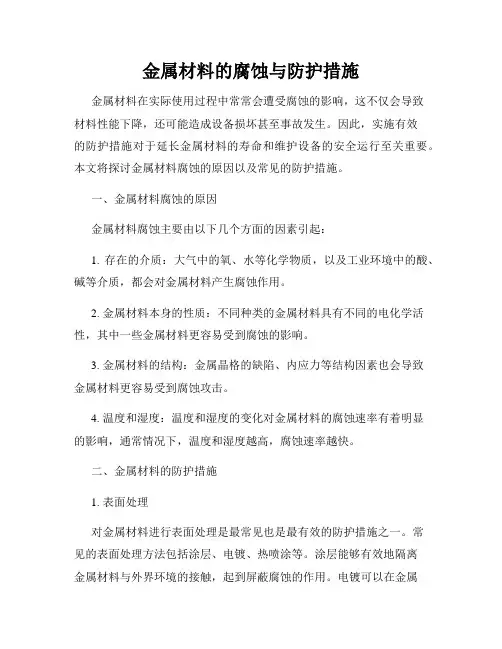
金属材料的腐蚀与防护措施金属材料在实际使用过程中常常会遭受腐蚀的影响,这不仅会导致材料性能下降,还可能造成设备损坏甚至事故发生。
因此,实施有效的防护措施对于延长金属材料的寿命和维护设备的安全运行至关重要。
本文将探讨金属材料腐蚀的原因以及常见的防护措施。
一、金属材料腐蚀的原因金属材料腐蚀主要由以下几个方面的因素引起:1. 存在的介质:大气中的氧、水等化学物质,以及工业环境中的酸、碱等介质,都会对金属材料产生腐蚀作用。
2. 金属材料本身的性质:不同种类的金属材料具有不同的电化学活性,其中一些金属材料更容易受到腐蚀的影响。
3. 金属材料的结构:金属晶格的缺陷、内应力等结构因素也会导致金属材料更容易受到腐蚀攻击。
4. 温度和湿度:温度和湿度的变化对金属材料的腐蚀速率有着明显的影响,通常情况下,温度和湿度越高,腐蚀速率越快。
二、金属材料的防护措施1. 表面处理对金属材料进行表面处理是最常见也是最有效的防护措施之一。
常见的表面处理方法包括涂层、电镀、热喷涂等。
涂层能够有效地隔离金属材料与外界环境的接触,起到屏蔽腐蚀的作用。
电镀可以在金属材料表面形成一层抗腐蚀的保护层,提高材料的耐腐蚀性能。
热喷涂技术可以将抗腐蚀性能较好的材料喷涂在金属表面,形成保护层。
2. 合金化合金化是一种改变金属材料性能的方法,通过将其他元素与主要金属元素混合,使得合金材料具有更好的耐腐蚀性能。
例如,不锈钢是一种通过在铁中添加铬等元素来提高其耐腐蚀性的合金材料。
3. 电化学防护电化学防护是利用电化学原理来保护金属材料的一种方法。
常见的电化学防护方法包括阳极保护和阴极保护。
阳极保护是通过在金属材料表面形成阳极,以减缓金属腐蚀的进程。
阴极保护则是通过将一种能够更容易被腐蚀的金属连接到要保护的金属材料上,使其成为电池中的阴极,从而实现金属材料的保护。
4. 环境改善改善使用环境也是一种有效的防护措施。
例如,在潮湿的环境中使用金属材料时,可以通过控制湿度或者增加通风来减缓腐蚀的速率。
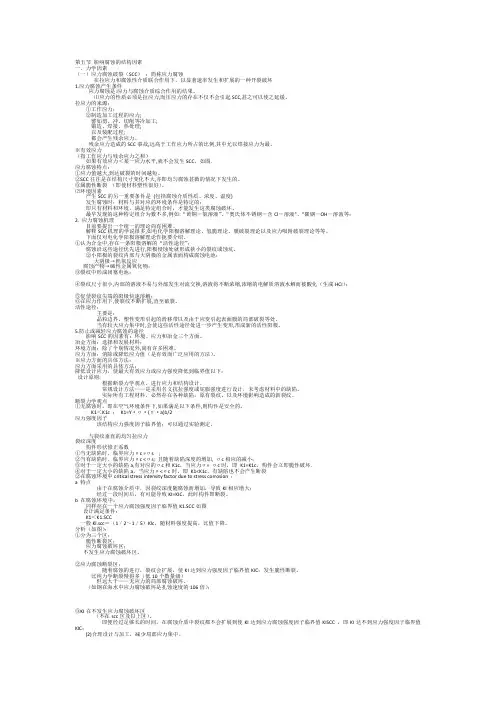
第五节影响腐蚀的结构因素一、力学因素(一)应力腐蚀破裂(SCC):简称应力腐蚀在拉应力和腐蚀性介质联合作用下,以显著速率发生和扩展的一种开裂破坏1.应力腐蚀产生条件应力腐蚀是:应力与腐蚀介质综合作用的结果。
⑴应力的性质必须是拉应力,而压应力的存在不仅不会引起SCC,甚之可以使之延缓。
拉应力的来源:①工作应力;②制造加工过程的应力;譬如剪、冲、切削等冷加工;锻造、焊接、热处理;以及装配过程;都会产生残余应力。
残余应力造成的SCC事故,远高于工作应力所占的比例,其中尤以焊接应力为最。
※有效应力(指工作应力与残余应力之和)如果有效应力<某一应力水平,就不会发生SCC。
如图.应力腐蚀特点:①应力值越大,到达破裂的时间越短。
②SCC往往是在结构尺寸变化不大,亦即均匀腐蚀甚微的情况下发生的。
③属脆性断裂(即使材料塑性很好)。
⑵环境因素产生SCC的另一重要条件是(包括腐蚀介质性质、浓度、温度)发生腐蚀时:材料与其对应的环境条件是特定的;即只有材料和环境,满足特定组合时,才能发生这类腐蚀破坏。
最早发现的这种特定组合为数不多,例如:“黄铜-氨溶液”、“奥氏体不锈钢-含Cl-溶液"、"碳钢-OH-溶液等;2. 应力腐蚀机理目前要提出一个统一的理论尚有困难。
解释SCC机理的学说很多,如电化学阳极溶解理论、氢脆理论、膜破裂理论以及应力吸附破裂理论等等。
下面仅对电化学阳极溶解理论作扼要介绍。
①认为合金中,存在一条阳极溶解的“活性途径”;腐蚀沿这些途径优先进行,阳极侵蚀处就形成狭小的裂纹或蚀坑。
②小阳极的裂纹内部与大阴极的金属表面构成腐蚀电池:大阴极→耗氧反应腐蚀产物→碱性金属氧化物;③裂纹中形成闭塞电池:④裂纹尺寸很小,内部的溶液不易与外部发生对流交换,溶液将不断浓缩,浓缩的电解质溶液水解而被酸化(生成HCI):⑤促使裂纹尖端的阳极快速溶解;⑥在应力作用下,使裂纹不断扩展,直至破裂。
活性途径:主要是:晶粒边界,塑性变形引起的滑移带以及由于应变引起表面膜的局部破裂等处。
影响腐蚀的材料因素
腐蚀是指材料在与外界环境作用时,其结构和性能发生不可逆的变化。
影响腐蚀的材料因素主要包括以下几个方面:
1. 材料本身的化学成分:不同化学成分的材料对于不同的腐蚀介质具有不同的抵抗能力。
通常来说,强耐蚀性的合金材料如不锈钢在一般环境下腐蚀较慢,而纯铁材料在同样条件下则腐蚀得更快。
2. 材料的晶体结构:晶体结构的不同对腐蚀也有很大影响。
一般来说,晶体结构越致密的材料越不容易被腐蚀。
例如,铝合金中的铝晶体结构较致密,因此具有较好的耐腐蚀性。
3. 材料的表面状态:材料的表面状态也会直接影响腐蚀的速度。
平滑、光洁的表面更不容易受到腐蚀,而有缺陷、有毛刺或氧化膜的表面则更容易发生腐蚀。
4. 材料的应力状态:材料在不同应力状态下腐蚀的速度也会有所变化。
一般来说,应力越大,材料的抵抗腐蚀的能力越弱。
同时,材料的应力状态还与腐蚀的方式和形态有关,例如应力腐蚀开裂就是应力状态对腐蚀产生的影响。
5. 材料的温度:温度是影响腐蚀速率的关键因素之一。
通常来说,在高温下,腐蚀速率会增加。
这是因为在高温下,腐蚀介质与材料的反应速度加快,同时材料的结构也会发生变化,导致更易受腐蚀。
综上所述,不同材料的化学成分、晶体结构、表面状态、应力状态以及温度等因素都会直接或间接地影响腐蚀的发生和发展。
了解和控制这些因素,可以有效地减少材料的腐蚀问题。
作者:admin发表时间:2010-03-02 08:49:41 回顾分析Ameco一千多架飞机重维修中所遇到的问题可以看出,最常见的结构故障就是飞机结构件的腐蚀。
飞机结构件的腐蚀问题是各型飞机中,长期面临的最大结构问题。
飞机的主要腐蚀类型从飞机设计和制造来看,不同金属的零部件相接触,造成不同金属之间的电位差和导电通路。
而各个部件组装在一起时,缝隙会存水和脏物形成电解质。
有些结构由于受力的需要又处于高应力状态形成应力腐蚀的根源。
而在制造过程中,由于生产工艺不当,保护性涂层做得不好,缺乏腐蚀控制措施等等原因,都可能带来腐蚀的隐患。
而在飞机使用过程中,飞行环境的恶劣,飞机表面涂层损坏,运输牲畜、海鲜等易产生强电解液体的货物都会使飞机结构产生腐蚀问题。
偶然污染如水银外溢,化学品外溢,厕所、厨房污物外溢和灭火剂残留物等,也都可能造成直接或间接的腐蚀。
而不恰当的飞机维修和勤务,也会使飞机面临更多的腐蚀问题。
飞机的腐蚀按其成因来分,主要可分为电化学腐蚀、表面锈蚀、应力腐蚀三大类,而电化学腐蚀是目前飞机最普遍和最严重的结构腐蚀之一。
电化学腐蚀是金属材料与电解质溶液接触时,在界面上发生有自由电子参加的广义氧化和广义还原反应,使金属元素以及晶格间的排列顺序发生改变,从而改变了原有金属的化学、物理、力学等性能。
飞机金属结构件的腐蚀大多数属于电化学腐蚀。
飞机的结构腐蚀如果不能得到有效的预防和控制,会造成结构修理工作量加大、修理周期延长、结构件大面积的加强和更换,由此导致很大的直接和间接经济损失,并造成飞机自身的不安全隐患。
腐蚀原因分析1.潮湿空气腐蚀环境潮湿空气是造成飞机结构腐蚀的重要因素之一。
潮湿空气与地理环境是紧密相连的,我国地理环境和气候条件十分复杂,受季风影响明显,全国大部地区都处在温暖而潮湿的东南季风和西南季风控制下,暖季节时比世界上同纬度的国家和地区的温度高,相对湿度和降雨量大。
这些都是我国各机场的飞机腐蚀问题较为严重的一个非常重要的原因。
钢结构腐蚀机理及影响因素初探作者:贾勇来源:《科学之友》2009年第05期摘要:20世纪以来,钢结构在全球得到很大发展,但是钢结构的腐蚀问题也越来越明显地凸显出来。
文章通过钢结构的腐蚀类型、腐蚀机理和影响钢结构腐蚀的因素的研究,提出钢结构的防腐措施。
关键词:钢结构;腐蚀;腐蚀机理;影响因素中图分类号:TQ630.17+9文献标识码:A文章编号:1000-8136(2009)14-0033-031钢结构腐蚀的类型和机理钢的腐蚀源于热力学性质的不稳定。
钢是铁制成的,而铁则是高炉中用焦炭中的碳对赤铁矿(Fe2O3)还原而得到的。
这一过程可用简单的化学反应式表示如下:2Fe2O3+3C→4Fe+3CO3(铁矿)(焦炭)(铁)(气体)该反应在极高温下发生,此过程中需要大量的能量,生成的最终产物铁和最终的钢是不稳定的。
其结果:当钢暴露于潮湿及有氧的环境中,铁将趋向于回复成原来的形态。
Fe+O2+3H2O→Fe2O3+3CO3(铁)(铁锈)铁锈是铁氧化物的水合物,其成分类似于赤铁矿,从而可解释在大多数情况下铁为何容易生锈,可以认为这个过程就是形成钢铁原始矿石的自然反应。
1.1 腐蚀的定义许多著名的学者对腐蚀的定义都有自己的表述。
20世纪50年代前对腐蚀的定义只局限于金属的腐蚀。
它是指金属与周围介质(主要是液体与气体)发生化学反应、电化学反应或物理溶解而产生的破坏。
随着非金属材料(如高分子合成材料)的迅速发展,从20世纪50年代以后,许多权威的腐蚀学者或研究机构倾向于把腐蚀的定义扩大到所有材料。
有人把腐蚀定义为:“由于材料和它所处的环境发生反应而使材料和材料的性质发生恶化的现象”。
也有人定义为:“腐蚀是由于物质与周围环境作用而产生的损坏”。
的确,非金属也存在腐蚀现象,如砖石的风化、木材的腐烂、塑料和橡胶的老化等都是腐蚀问题。
由于金属及其合金至今仍然是最重要的结构材料,同时金属也是极易遭受腐蚀的材料,所以本文主要讨论金属材料的腐蚀与防护问题。
钢结构的腐蚀原因及防腐措施的研究摘要:建筑空间集约化和施工高效环保是建筑行业的总体发展目标。
在此背景下,建筑钢结构得到了较快发展。
建筑钢结构在工业厂房、公共建筑以及民用住宅小区等方面都具有较广的应用。
钢结构在工程领域应用非常广泛,常应用于大跨度结构,高层结构等。
钢结构受到腐蚀后其力学性能会大大降低,进而缩短钢结构的使用寿命,降低工程的安全性,造成巨大的经济损失。
相关数据显示,世界每年因为钢结构腐蚀而造成的损失约占国民生产总量的3%~4%。
因此,对钢结构的腐蚀和防腐措施的研究具有重要意义。
关键词:钢结构;腐蚀原因;防腐措施引言钢结构轻质高强,具备良好的塑性变形能力以及冲击韧性,易于装配式施工和回收,是一种环境友好和应用广泛的建筑材料。
但长期以来钢材存在腐蚀问题,易于在空气和潮湿环境下腐蚀,尤其在海洋大气环境中的钢结构更易产生严重的腐蚀,进而导致钢结构截面削弱等不利影响,给结构安全埋下重大隐患,钢材腐蚀严重威胁到了建筑安全,在设计阶段对钢结构进行防腐设计能提高钢结构的耐久性。
1钢结构腐蚀的主要原因钢结构建筑长期外露,在空气中受雨水侵蚀锈蚀。
常温下的钢铁腐蚀主要为电化学腐蚀,常温大气环境下,钢材料受氧气、空气中水分以及结构表面污物、锈层、焊渣等因素影响,出现锈蚀和腐蚀情况。
空气湿度低于60%时,钢结构受轻微腐蚀;空气湿度超过钢材最大极限时(临界湿度),腐蚀情况比较严重,临界湿度为60%~70%。
钢结构建筑处于空气污染较严重的地区或沿海地区时,空气中的盐分含量较高,与正常大气环境相比,临界湿度更低,会在钢材表面形成一层水膜。
钢结构表面未处理完全的焊渣、锈层、氧化铁皮等为阴极,钢结构构件为阳极,会在水膜中发生电化学腐蚀反应,是引起钢结构腐蚀的主要原因。
2钢结构防腐技术2.1热浸锌防腐技术热浸锌防腐技术属于化学手段,正式使用前,有关人员需要按照一定比例调制锌液,将调制的锌液和硝酸钠溶液混合,搅拌至两者完全融合。